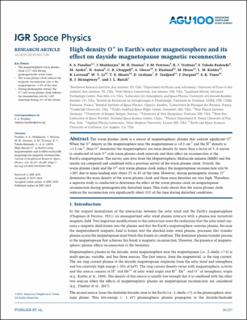High‐density O+ in Earth's outer magnetosphere and its effect on dayside magnetopause magnetic reconnection
Fuselier, SA; Mukherjee, J; Denton, MH; Petrinec, SM; Trattner, K.J.; Toledo-Redondo, S; Andre, M; Aunai, N; Chappell, Charles Richard; Glocer, Alex; Haaland, S.; Hesse, Michael; Kistler, LM; Lavraud, B; Li, WY; Moore, T. E.; Graham, D; Tenfjord, Paul; Dargent, J.; Vines, Sarah K.; Strangeway, Robert J.; Burch, J. L.
Journal article, Peer reviewed
Published version

View/
Date
2019Metadata
Show full item recordCollections
Original version
Journal of Geophysical Research: Space Physics. 2019, 124 (12), 10257-10269. 10.1029/2019JA027396Abstract
The warm plasma cloak is a source of magnetospheric plasma that contain significant O+. When the O+ density in the magnetosphere near the magnetopause is >0.2 cm‐3 and the H+ density is <1.5 cm‐3, then O+ dominates the magnetospheric ion mass density by more than a factor of 2. A survey is conducted of such O+‐rich warm plasma cloak intervals and their effect on reconnection at the Earth's magnetopause. The survey uses data from the Magnetospheric Multiscale mission (MMS) and the results are compared and combined with a previous survey of the warm plasma cloak. Overall, the warm plasma cloak and the O+‐rich warm plasma cloak reduce the magnetopause reconnection rate by >20% due to mass‐loading only about 2% to 4% of the time. However, during geomagnetic storms, O+ dominates the mass density of the warm plasma cloak and these mass densities are very high. Therefore, a separate study is conducted to determine the effect of the warm plasma cloak on magnetopause reconnection during geomagnetically disturbed times. This study shows that the warm plasma cloak reduces the reconnection rate significantly about 25% of the time during disturbed conditions.